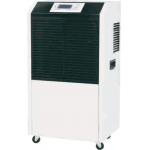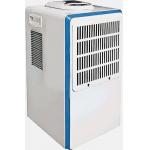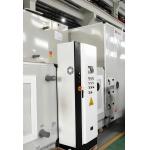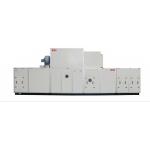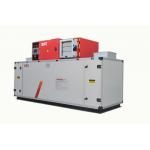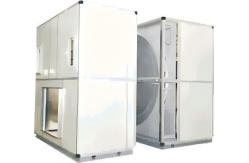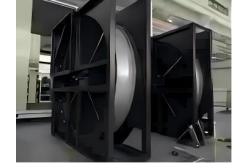|
A rotary total heat recovery system uses a rotating wheel to transfer both sensible (temperature) and latent (humidity) heat between exhaust and supply air streams, improving energy efficiency and indoor air quality. The rotating wheel, typically made of aluminum, absorbs heat from the exhaust air and transfers it to the incoming fresh air as it rotates between the two air streams.
- Rotating wheel: The core component that facilitates heat and moisture transfer.
- Casing: Encloses the rotating wheel and provides a housing for the system.
- Drive system: Powers the rotation of the wheel.
- Sealing parts: Ensure proper airflow and prevent leakage
By adopting advanced technologies and combining its own technical expertise, Jetex has continuously conducted research and development. Its modular rotary energy recovery unit has obtained a national patent (Patent No.: 200820049766.9, Patent Name: Rotary Energy Recovery Unit), featuring high efficiency, low cross-contamination, and the ability to be integrated with different air conditioners. This integration reduces the floor space required for machine rooms and installation costs.
Jetex Rotary Total Heat Recovery Uni Technical Parameters Table | 规 格Model | 新风风量 Fresh air flow (m³h) | 排风风量 Exhaust air flow (m³/h) | 热交换量 换热量 Heat Exchanger Capactity (kw) | 标准型 Standard | 高冷量型High cold | | | | | | 冷量 Cooling Capacity (kw) | 冰水量 Chilled Water Flow (m³/h) | 接管 Pipe DN | 冷量 Cooling Capacity (kw) | 冰水量 Chilled Water Flow (m³/h) | 接管 Pipe DN | | 10 | 1000 | 1000 | 9 | 7.1 | 1.3 | DN25 | 8.9 | 1.6 | DN25 | | 15 | 1500 | 1500 | 13.5 | 10.7 | 2 | DN25 | 13.4 | 2.4 | DN25 | | 20 | 2000 | 2000 | 18 | 14.2 | 2.6 | DN25 | 17.8 | 3.2 | DN25 | | 25 | 2500 | 2500 | 22.5 | 17.8 | 3.2 | DN32 | 22.3 | 4 | DN32 | | 30 | 3000 | 3000 | 27 | 21.3 | 3.8 | DN32 | 26.7 | 4.8 | DN32 | | 35 | 3500 | 3500 | 31.5 | 24.9 | 4.5 | DN40 | 31.2 | 5.6 | DN40 | | 40 | 4000 | 4000 | 36 | 28.4 | 5.1 | DN40 | 35.6 | 6.4 | DN40 | | 45 | 4500 | 4500 | 40.5 | 32 | 5.7 | DN40 | 40.1 | 7.2 | DN40 | | 50 | 5000 | 5000 | 45 | 35.5 | 6.4 | DN40 | 44.5 | 8 | DN40 | | 60 | 6000 | 6000 | 54 | 42.6 | 7.6 | DN50 | 53.4 | 9.6 | DN50 | | 70 | 7000 | 7000 | 63 | 49.7 | 8.9 | DN50 | 62.3 | 11.1 | DN50 | | 80 | 8000 | 8000 | 72 | 56.8 | 10.2 | DN50 | 71.2 | 12.7 | DN65 | | 90 | 9000 | 9000 | 81 | 63.9 | 11.4 | DN50 | 80.1 | 14.3 | DN65 | | 100 | 10000 | 10000 | 90 | 71 | 12.7 | DN65 | 89 | 15.9 | DN65 | | 120 | 12000 | 12000 | 108 | 85.2 | 15.2 | DN65 | 106.8 | 19.1 | DN65 | | 140 | 14000 | 14000 | 126 | 99.4 | 17.7 | DN65 | 124.6 | 22.2 | DN65 | | 160 | 16000 | 16000 | 144 | 143.6 | 20.3 | DN65 | 142.4 | 25.4 | DN80 | | 180 | 18000 | 18000 | 162 | 127.8 | 22.8 | DN65 | 160.2 | 28.6 | DN80 | | 200 | 20000 | 20000 | 180 | 142 | 25.3 | DN80 | 178 | 31.7 | DN80 | | 220 | 22000 | 22000 | 198 | 156.2 | 27.8 | DN80 | 195.8 | 34.9 | DN80 | | 250 | 25000 | 25000 | 225 | 177.5 | 31.6 | DN80 | 222.5 | 39.6 | DN80 | | 280 | 28000 | 28000 | 252 | 198.8 | 35.4 | DN80 | 249.2 | 44.4 | DN80 |
The advantage of rotary total heat recovery unit A rotary total heat recovery unit offers high energy recovery efficiency, especially in cold climates, by transferring both sensible heat and moisture between air streams. This results in reduced energy consumption for heating and cooling, improved indoor air quality, and can mitigate issues like condensation and mold
|
